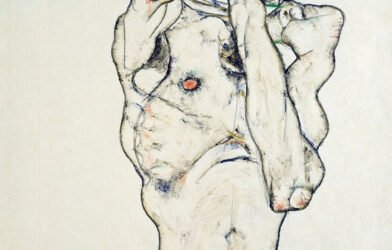Heinrich von Kleist, the German writer, once said that looking at a seascape by Caspar David Friedrich was like having your eyelids cut off. You were staring directly at death, at the loneliest center of the loneliest void. What could be better than that? A visitor to Friedrich’s studio, Helene von Kügelgen, suggested that the same painting would be less frightening if he put a sea monster in it. Anything to mitigate the loneliness. “Indeed, a thunderstorm would have consoled and delighted me,” she said. It was as if Friedrich had uncorked a drain at the bottom of the canvas and let everything vital spill out.
The painting in question, “The Monk by the Sea” (1808-1810), along with its pendant, “The Abbey in the Oakwood” (1809-1810), are the centerpieces of a bewitching new Friedrich retrospective at the Alte Nationalgalerie, in Berlin. The occasion is a slightly random jubilee: the two-hundred-and-fiftieth anniversary of Friedrich’s birth. Across Germany this year, there are exhibitions in Hamburg and Dresden, and more than a hundred and sixty events in Friedrich’s home town of Greifswald. There’s even a “Cake for Caspar” birthday party. For Kant, they didn’t roll out the red carpet until he was three hundred.
How did a man who painted foggy mountains and sunsets become the greatest German painter of the nineteenth century? The answer turns roughly on the year 1810, when Friedrich produced the two masterpieces now in the Alte Nationalgalerie. If you had to choose a single moment when painting became “modern,” you could do worse than choose the night—it had to be night—when Friedrich stepped back from “The Monk by the Sea,” in his studio in Dresden, and used a brush loaded with smalt blue to paint over three ships in the background. A simple act of subtraction—that was it. What remained: monk, dunes, sea, sky, and a few minimalist gulls. Even without looking at an infrared reflectogram, the paint is thin enough that you can see, up close, the faintest hint of the masts and rigging. What might have been a slightly creepy marine painting was turned into a portrait of the most impossible thing in the world to represent: emptiness.
“The Abbey in the Oakwood,” cut from the same bolt of canvas, trades in the emptiness for an actual funeral. A cortège of monks trickles into the portal of a ruined abbey, under a row of bare oak trees. There is a kind of capillary action at work here, as the light is sucked out of the sky by spindly branches. In the foreground, Friedrich has installed one of his go-to tropes: an open grave. Compare this with a neoclassical landscape by Pierre-Henri de Valenciennes, in France, or with the work of Joseph Anton Koch, Friedrich’s peer in Austria. Instead of placing you in a nice meadow with half-naked nymphs and plump sheep, Friedrich shoves you into a cold, dark pit.
Spend enough time in Friedrichland and you pick up on a trend in the iconography. A door is death, scissors are death, poplars are death, oak trees are death, the night is death, and boats are coffins. Rocks might symbolize faith, and moons hope, but the moment that the rocks are cairns, or the moon is a sickle, you’re out of luck again: death. When Friedrich was barely thirty, he was already inscribing his own name on crosses in his drawings: “Here rests C.D. Friedrich in God.”
The standard diagnosis for Friedrich’s angst involves a childhood accident. In 1787, at the age of thirteen, after already losing his mother and a sister, Friedrich and his younger brother Johann went out skating on a frozen moat. One version has it that Caspar fell in first, and that Johann died saving him. Another is that Caspar watched as his brother drowned. Either way, the plot writes itself: he became an artist who spent his life restaging this primal scene in one canvas after the next—reckoning with the sublime violence and wonder of the natural world. The Austrian writer Adalbert Stifter, Friedrich’s contemporary, imagined a moment in which “the beautiful silver mirror of a river swells, a boy falls in, the water ripples sweetly around his locks, he sinks—and after a short while the silver mirror swells as before.” It was not the death that was beautiful but the indifference of nature.
Growing up in Greifswald, on the Baltic coast, Friedrich was no stranger to the power of water, the sea having swallowed up Hanseatic merchants and Dutch fluyts by the thousands. Even though nature was vast and terrifying, Friedrich loved painting landscapes because they brought him closer to God. Every speck of dust and particle of moisture was endowed with His presence, and the painter was the medium through which He flowed. The task was to find the spiritual quiddity of God’s gifts in nature, piece by piece, and to assemble them into a divine whole.
In 1809, Friedrich’s budding pantheism landed him in hot water. Basilius von Ramdohr, a conservative art critic, published a long piece railing against Friedrich’s “Cross in the Mountains,” or “Tetschen Altar.” Every square inch of the canvas violated the principles of landscape painting. The butchering of perspective, the nonexistent foreground, the sapping of color and light—all of it was wrong, Ramdohr wrote. And Friedrich had planted the crucifix in the distance, all the way on top of a mountain, like a toothpick in a muffin. It was not befitting of the glory of Christ. Nor was it proper for lowly landscape painting to be put to the task of religious devotion, “to slink into the church and creep onto the altar.” The piece deepened the fault lines between Friedrich, the Romantic prince of sublimity and feeling, and the fusty rationalists who preceded him. In his tart reply, Friedrich mocked Ramdohr for lacking spirit: “You who are nothing but body!”









